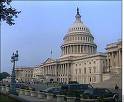Fiscal Collapse: US Congress to Make Sequester Cuts Permanent

Hundreds of thousands face unpaid furloughs
As the US government prepares to furlough hundreds of thousands of federal employees next month, Congress is moving to make permanent the $1.2 trillion in spending cuts over the next decade mandated by the sequester process that was triggered at the beginning of March.
The Democratic-controlled Senate is expected this week to approve a so-called “continuing resolution” that will fund the federal government through the end of the fiscal year on September 30. A version of the bill has already been passed by the Republican-controlled House of Representatives. Both the House and Senate versions include the $85 billion in cuts for fiscal year 2013 mandated by the sequester.
On top of these cuts, both versions of the bill include provisions to freeze federal pay through the end of this year, reversing an earlier executive order to end the current pay freeze and give federal employees a 0.5 percent raise.
With the sequester cuts secured for rest of the fiscal year, the two parties will intensify their discussions on next year’s federal budget and plans to impose unprecedented attacks on the most basic social programs—Medicare, Medicaid, and Social Security.
Congressional Democrats have made clear they have no intention of using the threat of a government shutdown, which would result from failure to pass a continuing resolution, in order to reverse the sequester cuts.
Since the exact form of the across-the-board sequester cuts are still being worked out, it is not clear precisely how many workers will face payless furloughs, but preliminary figures indicate that over one million employees could be affected. Many workers could lose more than 20 percent of their annual salary.
The spending bill passed by the House contains provisions giving the military much greater flexibility in distributing the burden of the spending cuts, meaning there will be little discernible impact on military capacity. The burden of the cuts will be born overwhelmingly by civilian employees of the military.
Admiral Jonathan Greenert, the Navy’s top uniformed officer, said earlier this month that compared to the original sequester provisions, the changes implemented in the bill are “almost night and day.” The admiral said that as a result of the bill, for instance, the Navy could proceed with the building of two new carriers whose construction it had previously threatened to halt.
“A huge portion of these cuts will come directly out of the pay of federal workers,” said Jackie Simon, the public policy director of the American Federation of Government Employees in a telephone interview Monday. “The Department of Defense has chosen to protect its contractors and make its civilian employees pay for the cuts,” she continued, adding that “the DOD spends over $200 billion per year on service contracts: none of these have been cut, and nothing is coming out of uniformed services.”
Then-Defense Secretary Leon Panetta said last month that the “vast majority” of the Defense Department’s 800,000 civilian employees would take 22 furlough days per fiscal year, resulting in pay cuts of 20 percent.
Employees affected by the defense department furloughs include workers at military hospitals and schools, employees at depots and arsenals and the sprawling defense department logistics system, as well as maintenance and repair staff.
Many thousands of non-military federal employees will also face unpaid furloughs. While most of the furlough days will be staggered throughout the year, 9,212 meat safety inspectors will all be furloughed on the same days, meaning no meat safety inspections will take place on 11 days of the year, Simon said.
The furloughs of federal employees come in addition to severe cuts in social services as a result of the sequester. The nearly 4 million long-term unemployed who receive federal unemployment benefits will see an 11 percent cut in their benefits, or about $130 per month.
The Center on Budget and Policy Priorities (CBPP) reported earlier this month that the “WIC nutrition program for low-income pregnant women, infants, and young children will have to turn away an estimated 600,000 to 775,000 women and children, including very young children, by the end of this fiscal year.”
Additionally, 100,000 low-income families will lose vouchers for housing assistance as a result of the sequester cuts, and tens of thousands of education workers will face layoffs.
Throughout the entire “debate” over the budget and federal deficit, the issues of unemployment, poverty and falling wages have gone virtually unmentioned. The joint goal of the Obama administration and congressional Republicans and Democrats is to manufacture an atmosphere of crisis, in which an immense assault on social services and workers’ living standards can be carried out.
The next crisis date will occur in August, when the federal debt ceiling will be reached. This will be utilized along prearranged lines to push through cuts and structural changes that will mark the beginning of the end of the basic social reforms enacted in the 1930s and 1960s.
Obama is resolutely pushing for cuts in Social Security benefits and hundreds of billions of further cuts in Medicare, as well as the introduction of means-testing, which will begin the transformation of the medical insurance program for seniors from a universal program to a poverty program, a major step toward its destruction.
The White House is seeking to spin this historic attack as a boon to the “middle class” and a “fair” and “balanced” approach to the deficit by linking it to token tax increases on the rich. Any such increases, however, would be more than made up for by a “reform” of the tax code that slashes corporate taxes and shifts the tax burden further from the wealthy to the working class.

